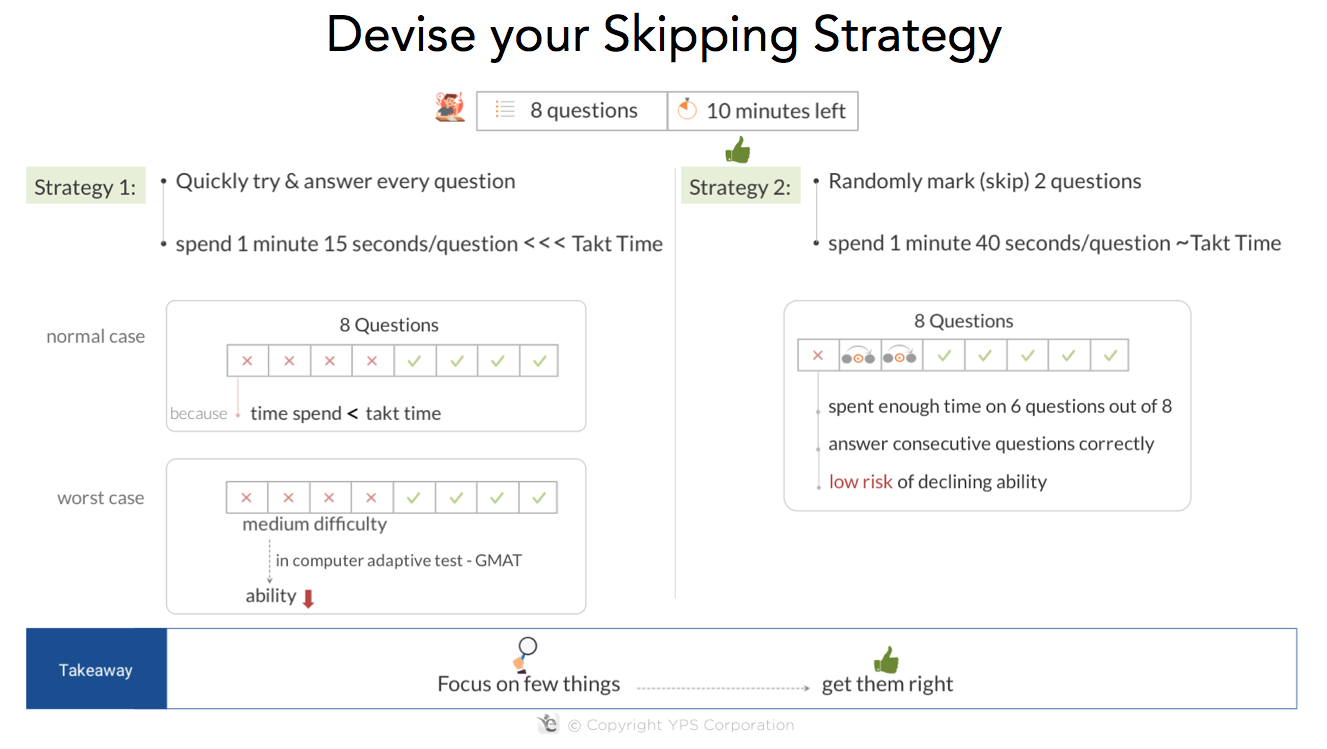Do you think that your timing strategy is the biggest reason you could not achieve your target score in GMAT? Are you worried about the timing strategy you should follow? I am sure you have come to this article wanting to know the reference/ideal amount of time to be spent on various types of questions and might have looked for some advice on it on different forums already. In this article, we will cover the ideal GMAT timing strategies the focus on leveraging the adaptive nature of GMAT to maximize score.
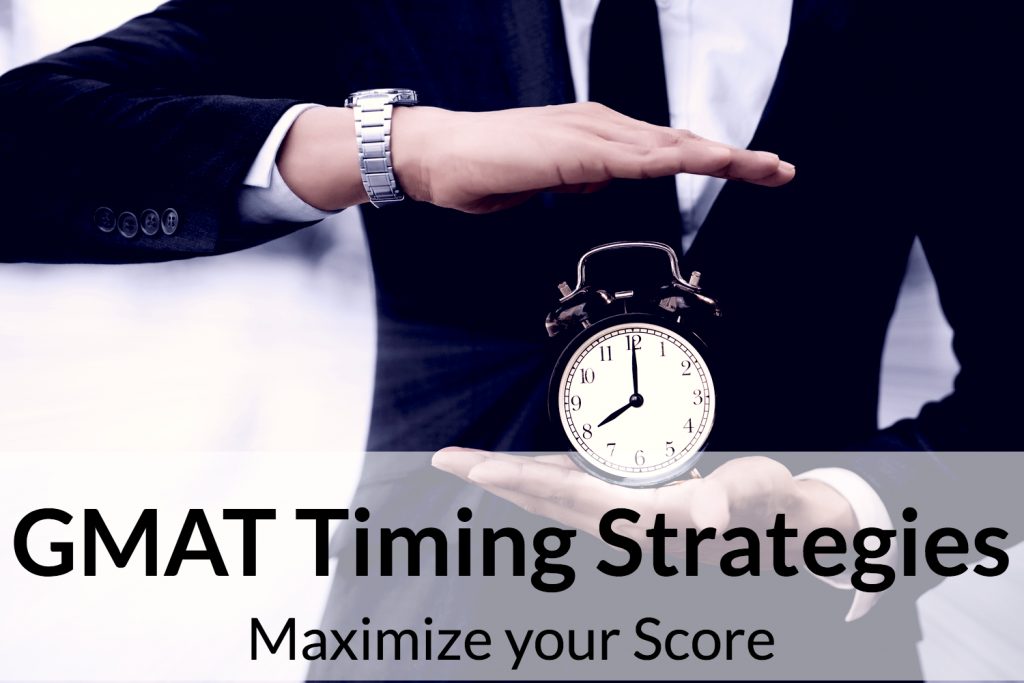
In this article you will read about:
- What is the optimal time?
- Knowing takt time to create GMAT timing strategies
- How to calculate takt time?
- How to reduce takt time and improve GMAT timing strategies?
- How to use the knowledge of takt time?
- Takeaways
The high-level timing strategy is to spend optimal time on your strengths and in case of shortage of time randomly mark an answer choice for questions that are from your weak sections. The chances of you getting an answer correct from your weak section are low even after spending time on it. The time saved on these questions can be used for other questions on which your chances of scoring are high. This is explained in detail later in the article.
What is the Optimal Time?
I am sure you want to know the reference/ideal amount of time to be spent on various types of questions and must have looked for some advice on it on different forums already. In a world where mass personalization will soon become a norm, why should there be one standard for everyone here! Each student has his/her own strengths and core skills which directly affects the time required to solve questions. At this point, I would like to introduce you to a term called ‘Takt Time’ in reference to GMAT. The concept of takt time has been borrowed from Manufacturing and is derived from a German word Taktzeit meaning cycle time. In GMAT reference it means the average time required to solve questions of a particular type correctly.
For any strategic advice for GMAT or MBA Admissions, write to us at acethegmat@e-gmat.com. Take a free trial to get unlimited access to concept files, live sessions, and practice questions.
From the definition above, you must have guessed that the average amount of time required to solve questions correctly, in other words, Takt Time, will have the following features:

- It is user-specific, i.e. it varies from person to person
- It is calculated only for correct questions (if only we could mark all the questions correctly! *Sigh*)
- It is different for different sections of GMAT. Usually, students solve SC questions faster than CR and RC in Verbal. Similarly, for Quant depending upon your proficiency level in various sections, your time to solve questions correctly will vary
- It is an average measure, i.e. it takes into account your time to answer easy, medium, and hard questions. This is deliberately done because it will be difficult for you to assess the level of questions in the actual test and time yourself to that precision
Confused between taking the GMAT or the CAT for MBA Admissions? Read this article, GMAT vs CAT and How to choose the right test to learn more.
Why is it important to know Takt Time for creating your GMAT timing strategy?
The ultimate aim of any test taker is to maximize the score. Everything else is done to achieve this goal. One of the ‘everything else’ to be done is manage time properly so that it does not affect the score adversely. Pacing yourself appropriately is important because:
- If you rush through you may make errors and thereby affect your score. Let’s take the example of a student who has an Ability of 80%ile in SC when he spends 1 minute 30 seconds on an average to solve the questions. If he panics under the perceived time pressure in the exam and spends only 1 minute 10 seconds on an average on SC questions, his Ability might drop to 40%ile. In order to save 20 seconds per question, he ends up making more mistakes and his score drops.
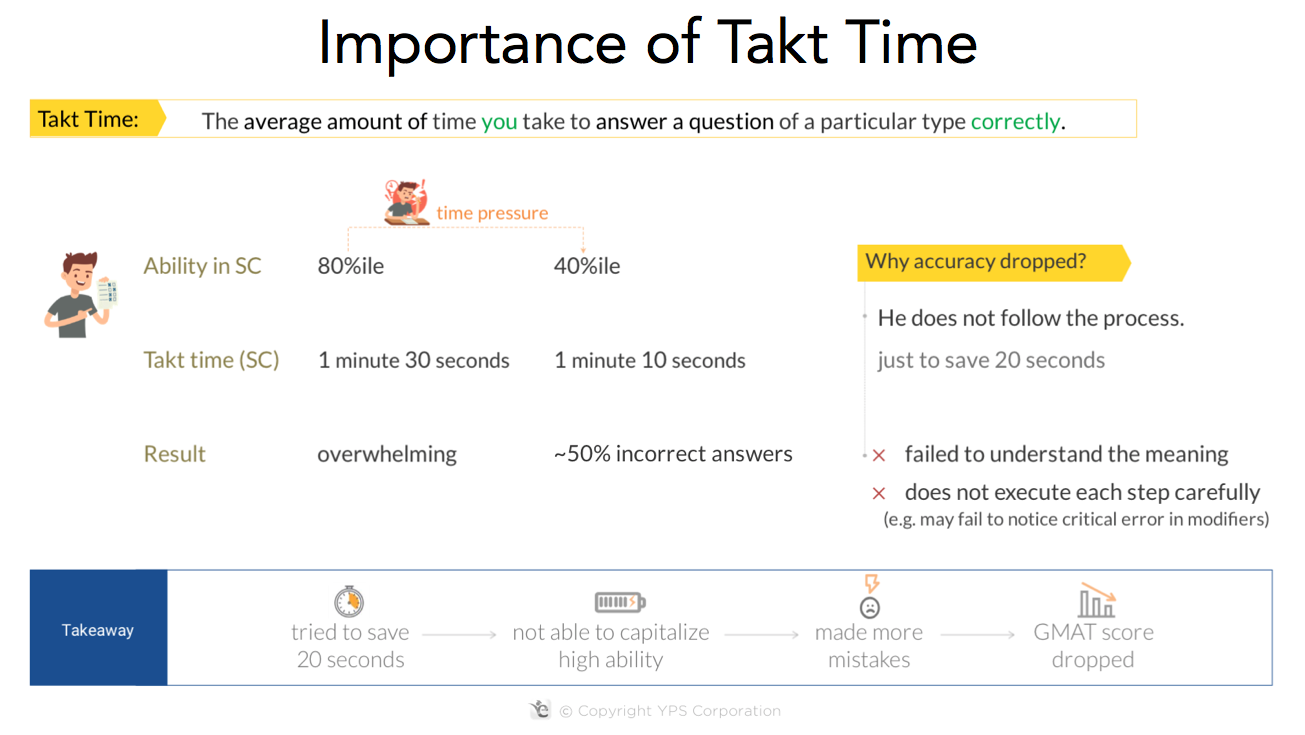
- If you take too much time in the beginning, you are likely to fall short of time later and will have to rush in the end which will again impact your score. GMAT penalizes heavily for every question that is left unanswered. How heavy is this “heavily”? According to Official Guide 2019, not answering five questions in Verbal could reduce the score from the 91st percentile to the 77th!
Check out Jaqueline’s success story on how knowledge of Takt Time helped her in her preparation phase. She scored 720 (Q49, V40) on the GMAT.
How to calculate your Takt Time?
Takt Time for a particular section = Average amount of time taken to solve questions of that section correctly
- If you are an e-GMAT student, you will get this information from Skill Data section of Scholaranium
- If you are not an e-GMAT student, you will have to time questions that you practice to do the calculation manually or figure out ways to get it from the resources you use
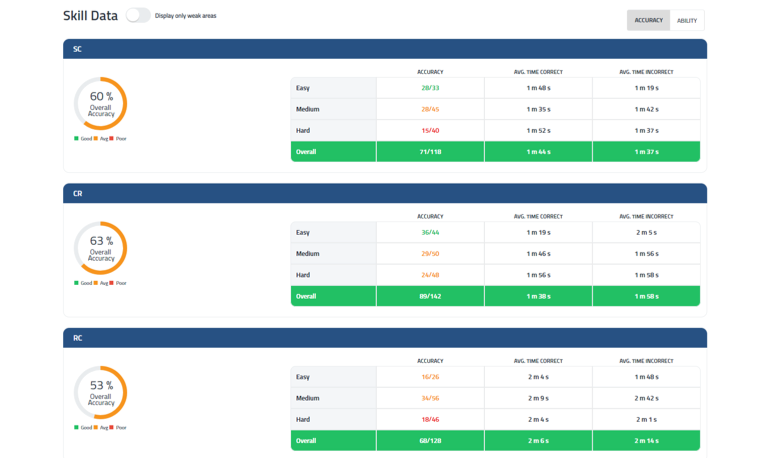
How to Reduce Takt Time and improve GMAT Timing Strategies?
Now if you find that your Takt time is too high, i.e. it is more than 2.5 minutes for CR/RC or around 2 minutes for SC, and you have time before your test, you may want to bring these timings down for a high score. How would you do it? First by understanding what affects Takt Time and then working on those aspects to improve this timing.
Takt Time is directly proportional to
- Your ability to process information and apply the concepts
- Efficiency with which you apply the process to solve GMAT questions
Since both of these can be changed, it is very clear that Takt time is not static and will vary based on your proficiency in either or both parameters mentioned above. Let’s understand them one by one.
Ability to process information
Ability to process information is nothing but your ability to comprehend. It should be no surprise that if you comprehend fast, then you spend lesser time understanding the question and coming to the right answer. Comprehension for GMAT can be improved by improving:
- Focus
- Knowledge of Structure
Hence, now the question is how to improve focus and knowledge of structure? Let us break these down as well.

Improve Focus
If you are one of those who has no problem in remaining concentrated on a task at hand for long hours, this section is not meant for you. But most people find themselves getting distracted or not being able to remain focused on the task at hand for even a short duration. If you are one of those, all is not lost. You can train your mind to focus. Begin with shorter sessions. Start with studies in batches of 30 minutes and in those 30 minutes do nothing else but focus on reading and applying the process on questions. Make sure there is no external disturbance and if your mind starts drifting away, you must stop immediately and come back to studies.
Leveraging Knowledge of Structure
If you understand the ways in which authors can change the course of a sentence or a paragraph, then you can start predicting what is going to come next. This is especially helpful in CR and RC. One way to improve your knowledge of structures is to read from good sources. Recommended reading lists for GMAT include The Economist, The New York Times, The Wall Street Journal, etc. because the structures used in these publications is similar to what is tested on GMAT. When you read from these publications, make a note of any new structure that you come across and try to learn the possible ways in which that structure can be used. This would also improve your reading speed which will, in turn, help you in Verbal section of GMAT.
Efficiency to apply the process – Effective Time Management on the GMAT
It is important that a student applies the process well in the first go. If a student misses a step in the process just to save some time, he would be required to go back and forth to solve the question which would result in more time being wasted. Let’s take CR for example. If the student follows the process properly he will take approximately 55 seconds to read the argument, 15 seconds to pre-think the assumption and another 35 seconds to select the correct answer, thereby taking 1 minute 45 seconds to solve the question.
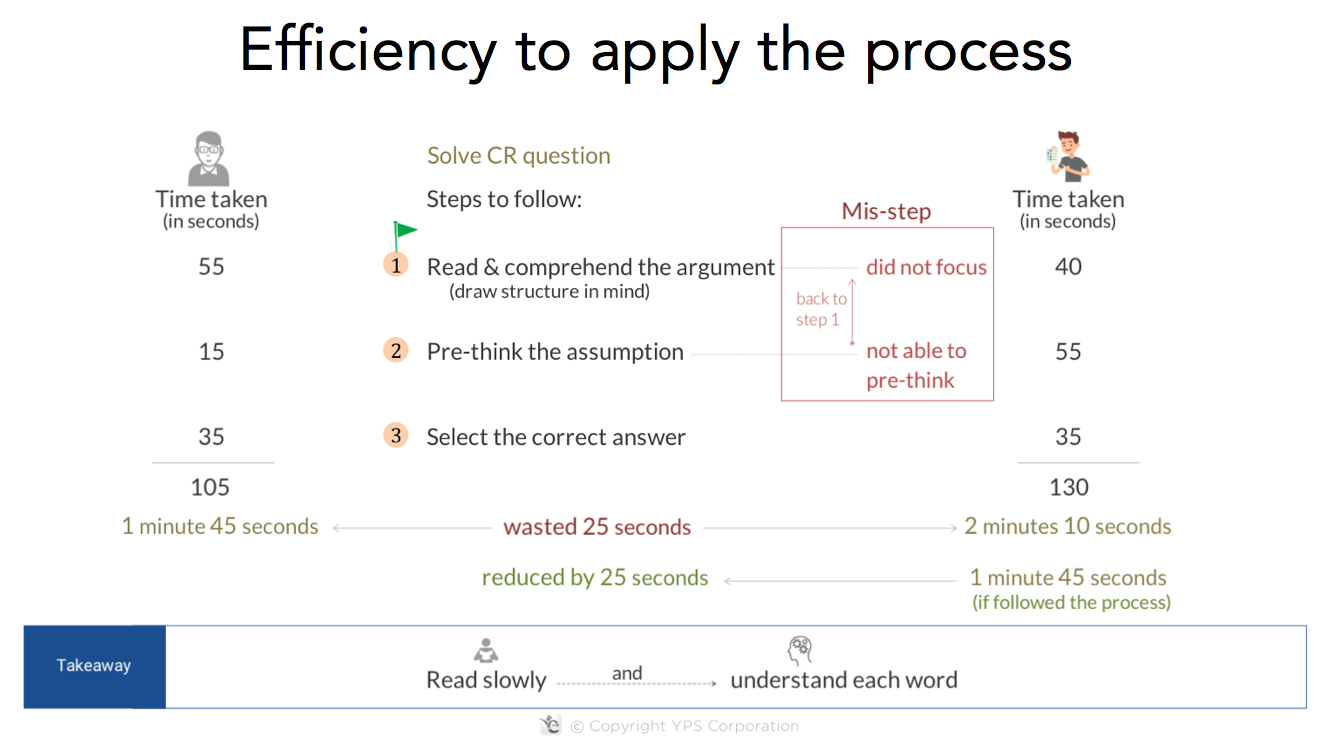
Now if this student tries to rush in the first step to save some time, he would falter in the second step that is he would not be able to pre-think the assumption and would have to go back to reading the argument again. Because the student was not efficient in the first go, the time he would now take would be 40 seconds to read and comprehend the argument, 55 seconds to pre-think the assumption, and another 35 seconds to select the correct answer thereby taking 2 minutes and 10 seconds to solve the question. Every second saved is a second earned!
How to use the knowledge of Takt Time?
In the first article of this series, you saw that you need not answer every question correctly in order to get to your target score. The aim is to mkae the algorithm throw hard questions at you, and that is possible only if it feels you are capable of handling medium level questions well. To make the algorithm believe so you must answer the first few questions correctly as described in the first article of this series. The strategy, therefore, is to Build – Build – Maintain – Maintain.
Score Maximization Strategy – Build – Build – Maintain – Maintain
The total number of questions in a section should be divided into four blocks. For, e.g. 36 questions of Verbal can be divided into blocks of 9. According to this strategy, you must devote time in accordance with your takt time in the first two blocks to build up the difficulty level of questions thrown at you in the test. In the next two blocks, your strategy should be to maintain this level in the remaining time. In case you ended up taking too much time in the first two blocks and do not have enough time to solve all the questions of the last two blocks in the remaining time you must use the Skipping Strategy as described below.
Devise your Skipping Strategy
This strategy should be used along with the above strategy to maximize score. Let’s take a case where after the first three blocks you have just 10 minutes left for the last 8 questions. Should you try to solve all of them or pick the ones you are more likely to solve correctly? Let’s see what happens in both these cases:
Learn more about the Skipping Strategy from our course on “Your Study Plan”
In Strategy 1, the student tries to answer all the questions correctly thereby spending approximately 1 minute 15 seconds per question. This is much lesser than his takt time and therefore increases the chances of getting more number of incorrect answers. Marking a string of questions incorrect especially that of medium or easy difficulty level will result in a lower score for the student.
On the other hand, as in Strategy 2, if this student decides to skip (randomly mark) two questions, he would have approximately 1 minute 40 seconds per question which is closer to his Takt time. This would result in better accuracy. Having more number of answers correct in a row will reduce the risk of decline in Ability.
Learn how Alok used the concept of Takt Time and Skipping Strategy and scored 740 in GMAT.
Takeaway
The key to maximizing GMAT score is efficient time management using an effective timing strategy. You must leverage the adaptive nature of the GMAT to ensure that you get a shot at higher difficulty level questions and solve most of them correctly so that the algorithm estimates your ability to be high. Since each one of you has your own strengths and weaknesses, your timing strategy on the GMAT can’t be based on general reference timings but based on your Takt Time. Using all the information in this article, keep a timing strategy ready before you take mocks. Test your strategy in the mocks and if required adapt it more to your needs!
Write to us at acethegmat@e-gmat.com for any queries regarding your timing strategy on the GMAT!


